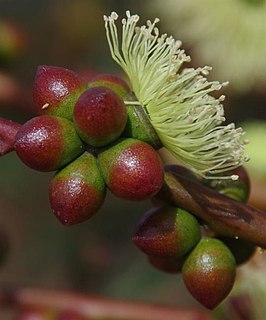Eucalyptus vicina, commonly known as the Manara Hills red gum, is a species of mallee in the family Myrtaceae and is endemic to western New South Wales. It has smooth bark, lance-shaped to curved adult leaves, flower buds in groups of seven, white flowers and cup-shaped or hemispherical fruit.

Eucalyptus goniocarpa is a species of mallet, that is endemic to southern Western Australia. It has smooth bark, glossy bluish adult leaves, flower buds in groups of three, creamy-white flowers, and ribbed, conical to barrel-shaped fruit.
Eucalyptus jimberlanica, commonly known as Norseman gimlet, is a species of mallet or a tree and is endemic to a small area in the Goldfields-Esperance region of Western Australia. It has smooth, brownish bark, lance-shaped adult leaves, flower buds in groups of seven and conical to cup-shaped fruit.
Eucalyptus kenneallyi, commonly known as Kenneally's white gum, is a species of tree that is endemic to two small islands off the Kimberley coast of Western Australia. It has smooth bark, lance-shaped adult leaves, flower buds in groups of seven, white flowers and cylindrical fruit.
Eucalyptus luculenta is a species of mallee that is endemic to a small area on the south coast of Western Australia. It has smooth bark, lance-shaped to egg-shaped leaves, flower buds in groups of seven, pale yellow to white flowers and cup-shaped, barrel-shaped or cylindrical fruit.
Eucalyptus optima, is a species of small to medium-sized tree or a mallet that is endemic to a small area in the south of Western Australia. It has smooth white to greyish bark, sometimes with rough black bark on the base of the trunk, lance-shaped adult leaves, flower buds in groups of seven or nine, pale yellow flowers and cup-shaped, hemispherical or urn-shaped fruit.
Eucalyptus ravida is a species of small mallet that is endemic to Western Australia. It has smooth, shiny bark, lance-shaped adult leaves, flower buds in groups of seven, white flowers and conical to hemispherical fruit.
Eucalyptus singularis is a species of mallet that is endemic to Western Australia. It has smooth bark, sometimes with ribbons of rough bark at the base, lance-shaped adult leaves, flower buds usually in groups of seven, pale yellow flowers and cylindrical to barrel-shaped fruit.
Eucalyptus spreta is a species of mallet or marlock that is endemic to the south coast of Western Australia. It has smooth bark, narrow lance-shaped to curved adult leaves, flower buds in groups of seven, white flowers and cup-shaped fruit.
Eucalyptus tortilis is a species of mallet and a gimlet that is endemic to the southwest of Western Australia. It has smooth bark, lance-shaped adult leaves, flower buds in groups of seven, creamy white flowers and hemispherical to cup-shaped fruit.
Eucalyptus ultima is a species of mallee that is endemic to a small area in the Gascoyne region of Western Australia. It has smooth bark, linear to narrow lance-shaped leaves, flower buds in groups of nine to fifteen, white flowers and spherical to cup-shaped fruit.
Eucalyptus urna, commonly known as merrit, is a species of mallet or marlock that is endemic to southern areas of Western Australia. It has smooth bark, lance-shaped adult leaves, flower buds in groups of seven to thirteen, creamy yellow to white flowers and urn-shaped fruit.

Corymbia ferriticola, commonly known as the Pilbara ghost gum, is a species of tree or a mallee that is endemic to Western Australia. It has smooth bark, lance-shaped adult leaves, flower buds in groups of seven, creamy white flowers and shortened spherical to cylindrical fruit.
Eucalyptus creta, commonly known as the large-fruited gimlet, is a species of mallet or tree that is endemic to Western Australia. It has smooth, shiny bark, lance-shaped adult leaves, flower buds in groups of three in leaf axils, relatively large white to creamy yellow flowers, and broadly hemispherical to bell-shaped fruit.
Eucalyptus delicata is a species of tree that is endemic to Western Australia. It has rough, fibrous to scaly bark on the trunk, smooth white to greyish bark above, linear to narrow lance-shaped adult leaves, flower buds in groups of between seven and eleven, creamy white flowers and more or less spherical to barrel-shaped fruit.

Eucalyptus extensa is a species of mallet that is endemic to Western Australia. It has smooth bark, lance-shaped adult leaves, flower buds in groups of seven, yellowish green flowers and hemispherical fruit with the valves extended well beyond the level of the rim.
Eucalyptus foliosa is a species of mallee that is endemic to Western Australia. It has a dense crown with foliage reaching to the ground, smooth greyish bark, linear to narrow lance-shaped or narrow oblong adult leaves, flower buds in groups of seven or nine, white flowers and conical to shortened hemispherical fruit. It is only known from a small area near Esperance.
Eucalyptus tephrodes is a species of small tree or mallee that is endemic to Western Australia. It has rough bark on the trunk and larger branches, smooth bark above, egg-shaped to lance-shaped adult leaves, flower buds in groups of three on the ends of branchlets and cup-shaped to hemispherical fruit.

Eucalyptus terebra, commonly known as Balladonia gimlet, is a species of gimlet that is endemic to Western Australia. It has satiny or glossy bark on its fluted trunk, linear to narrow lance-shaped adult leaves, flower buds in groups of seven, yellowish flowers and conical to hemispherical fruit. It is one of the seven species of gimlet.

Eucalyptus socialis subsp. eucentrica, commonly known as the inland red mallee, is a subspecies of mallee that is endemic to inland Australia. It usually has rough bark on the base of the trunk, smooth bark above, lance-shaped adult leaves, flower buds in groups of between seven and eleven, pale creamy yellow flowers and barrel-shaped to urn-shaped or spherical fruit.




